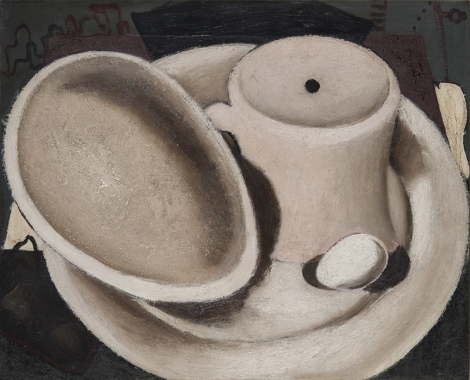John Graham: Maverick Modernist
May 7–July 30, 2017
John Graham: Maverick Modernist is a comprehensive survey of significant scope and scholarship, exploring how the artist became an influential figure in the development of a distinctly American approach to art-making in the first half of the twentieth century, and in what ways Graham’s own self-reinvention as an artist mirrors the resourcefulness and ambition of American artists defining a new direction. The exhibition is organized by Alicia G. Longwell, the Parrish’s Lewis B. and Dorothy Cullman Chief Curator, Art and Education, along with guest co-curator Karen Wilkin, independent curator, scholar, and critic, and consulting curator William C. Agee, Evelyn Kranes Kossak Professor of Art History Emeritus, Hunter College, City University of New York. Featuring approximately 65 paintings and a selection of important works on paper from the entire expanse of Graham’s four decade career, the exhibition is accompanied by a fully-illustrated, 150-page catalogue with interpretive essays by the curators.
Much of the history of American art in the first half of the twentieth century pivots on the artist John Graham, who turns up Zelig-like in every circle of influence in the period. In the 1920s he advised the Cone Sisters of Baltimore on their collection. His most significant early patron and advisor was the collector and museum founder Duncan Phillips. It was in a letter to Phillips at the end of 1930 that Graham first articulated his ardent desire to become above all else an American painter: “Stuart Davis, [Arshile] Gorky and myself have formed a group and something original, purely American, is coming out from under our brushes.“ His friend and confidant, the collector Katherine S. Dreier, advised him during the 1930s on the publication of his wide-ranging treatise System and Dialectics of Art; and Jackson Pollock quickly sought him out after reading Graham’s 1937 Magazine of Art article “Primitive Art and Picasso.”
During the early 1940s, he deviated from his earlier allegiance to Picasso and a synthetic cubist style and began to produce historicizing portraits, almost exclusively of women, that looked back to Raphael and Ingres. One critic judged that he had turned on modernism and reconnected to his roots as a counter-revolutionary. As with most artists who drastically change their style (Philip Guston comes to mind), Graham’s radical reversal has been widely misconstrued. Yet the fact that his cross-eyed courtesans remain the most widely known examples of his work indicates that these portraits may not be a renunciation of modernism as much as a validation of an artist’s freedom to regenerate. Graham’s self-styled notion of the artist as alchemist and shaman has found fertile ground in the art of the last fifty years, from Andy Warhol’s oxidation paintings to Mike Kelley’s protean incarnations. In reconciling the two phases of Graham’s career, this exhibition will look beyond the easy assumptions to reveal in what ways Graham’s early and late styles are fully congruent. A linear history does not easily accommodate figures like Graham; it is the goal of this exhibition and catalogue to firmly secure his place in the annals of twentieth-century art.
John Graham: Maverick Modernist is made possible, in part, by the generous support of the Henry Luce Foundation and the Century Arts Foundation.
Additional support is provided by The Liliane and Norman Peck Fund for Exhibitions, The Mr. and Mrs. Raymond J. Horowitz Fund for Publications, and Barbara Slifka. The Parrish Art Museum wishes to also acknowledge Ariel and Alaleh Ostad Charitable Annuity Trust, Henry & Elaine Kaufman Foundation, Robert and Arlene Kogod, Myron Kunin Collection, Boris Lurie Art Foundation, Steve Martin and Anne Stringfield, Herman Goldman Foundation, Allison Stabile, and Jeremy Patricia Stone. WSHU is the exclusive radio sponsor.








